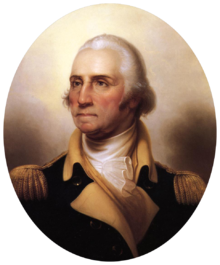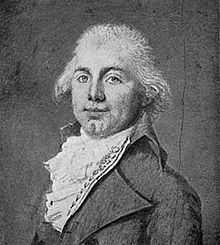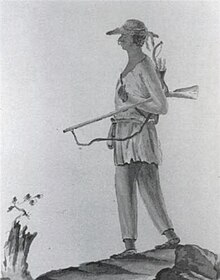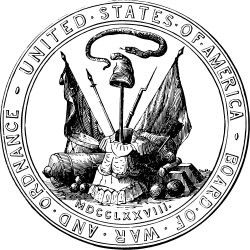|
Continental Army
The Continental Army was the army of the United Colonies representing the Thirteen Colonies and later the United States during the American Revolutionary War. It was formed on June 14, 1775, by a resolution passed by the Second Continental Congress, meeting in Philadelphia after the war's outbreak. The Continental Army was created to coordinate military efforts of the colonies in the war against the British, who sought to maintain control over the American colonies. General George Washington was appointed commander-in-chief of the Continental Army and maintained this position throughout the war. The Continental Army was supplemented by local militias and volunteer troops that were either loyal to individual states or otherwise independent. Most of the Continental Army was disbanded in 1783 after the Treaty of Paris formally ended the war. The Continental Army's 1st and 2nd Regiments went on to form what was to become the Legion of the United States in 1792, which ultimately served as the foundation for the creation of the United States Army. OriginsThe Continental Army consisted of soldiers from all the Thirteen Colonies and, after 1776, from all 13 states. The American Revolutionary War began at the Battles of Lexington and Concord on April 19, 1775, at a time when the colonial revolutionaries had no standing army. Previously, each colony had relied upon the militia (which was made up of part-time citizen-soldiers) for local defense; or the raising of temporary provincial troops during such crises as the French and Indian War of 1754–1763. As tensions with Great Britain increased in the years leading to the war, colonists began to reform their militias in preparation for the perceived potential conflict. Training of militiamen increased after the passage of the Intolerable Acts in 1774. Colonists such as Richard Henry Lee proposed forming a national militia force, but the First Continental Congress rejected the idea.[2] On April 23, 1775, the Massachusetts Provincial Congress authorized the raising of a colonial army consisting of 26 company regiments. New Hampshire, Rhode Island, and Connecticut soon raised similar but smaller forces. On June 14, 1775, the Second Continental Congress decided to proceed with the establishment of a Continental Army for purposes of common defense, adopting the forces already in place outside Boston (22,000 troops) and New York (5,000). It also raised the first ten companies of Continental troops on a one-year enlistment, riflemen from Pennsylvania, Maryland, and Virginia to be used as light infantry. The Pennsylvania riflemen became the 1st Continental Regiment in January 1776. On June 15, 1775, Congress elected by unanimous vote George Washington as Commander-in-Chief, who accepted and served throughout the war without any compensation except for reimbursement of expenses.[3] As the Continental Congress increasingly adopted the responsibilities and posture of a legislature for a sovereign state, the role of the Continental Army became the subject of considerable debate. Some Americans had a general aversion to maintaining a standing army; but on the other hand, the requirements of the war against the British required the discipline and organization of a modern military. As a result, the army went through several distinct phases, characterized by official dissolution and reorganization of units. EstablishmentsThe Continental Army's forces included several successive armies or establishments:
OrganizationGoverning bodiesMilitary affairs were at first managed by the Continental Congress in plenary session, although specific matters were prepared by a number of ad hoc committees. In June 1776 a five-member standing committee, the Board of War and Ordnance, was established in order to replace the ad hoc committees. The five members who formed the Board fully participated in the plenary activities of Congress as well as in other committees and were unable to fully engage in the administrative leadership of the Continental Army. A new Board of War was therefore formed in October 1777, of three commissioners not member of Congress. Two more commissioners, not members of Congress, were shortly thereafter added, but in October 1778, the membership was set to three commissioners not members of Congress and two commissioners members of Congress. In early 1780, the Quartermaster General, the Commissary General of Purchase, and the Commissary General of Issue were put under the direction of the Board. The Office of the Secretary at War was created in February 1781, although the Office did not start its work until Benjamin Lincoln assumed the office in October 1781.[5] Commander-in-chief On June 15, 1775, Congress elected by unanimous vote George Washington as Commander-in-Chief, who accepted and served throughout the war without any compensation except for reimbursement of expenses.[3] Washington, as commander-in-chief, was supported by a chief administrative officer, the Adjutant General. Horatio Gates held the position (1775–1776), Joseph Reed (1776–1777), George Weedon and Isaac Budd Dunn (1777), Morgan Connor 1777, Timothy Pickering (1777–1778), Alexander Scammell (1778–1781), and Edward Hand (1781–1783).[6] An Inspector General assisted the Commander-in-Chief through periodically inspecting and reporting on the condition of troops. The first incumbent was Thomas Conway (1777–1778), followed by Baron von Steuben 1778–1784, under whom the position became that of a de facto chief of staff.[7] The Judge Advocate General assisted the commander-in-chief with the administration of military justice, but he did not, as his modern counterpart, give legal advise. William Tudor was the first appointee.[8] He was followed by John Laurance in 1777 and Thomas Edwards in 1781[9] The Mustermaster General kept track by name of every officer and man serving in the army. The first mustermaster was Stephen Moylan.[10] He was followed by Gunning Bedford Jr. 1776–1777 and Joseph Ward.[9] Territorial organizationUnits of the Continental Army were assigned to any one of the territorial departments to decentralize command and administration. In general there were seven territorial departments,[11] although their boundaries were subject to change and they were not all in existence throughout the war. The Department of New York (later the Northern Department) was created when Congress made Philip Schuyler its commander on June 15, 1775. The Southern and Middle Departments were added in February 1776. Several others were added the same year. A major general appointed by Congress commanded each department. Under his command came all Continental Army units within the territorial limits of the department, as well as state troops and militia – if released by the governor of the state.[12] Tactical organizationAll troops under the department commander were designated as an army; hence troops in the Northern Department were called the Northern Army, in the Southern Department the Southern Army, etc. The department commander could be field commander or he could appoint another officer to command the troops in the field. Depending on the size of the army, it could be divided into wings or divisions (of typically three brigades) that were temporary organizations, and brigades (of two to five regiments) that in effect were permanent organizations and the basic tactical unit of the Continental Army.[13] An infantry regiment in the Continental Army typically consisted of 8 to 10 companies, each commanded by a captain. Field officers usually included a colonel, a lieutenant colonel, and a major. A regimental staff was made up of an adjutant, quartermaster, surgeon, surgeon's mate, paymaster, and chaplain. Infantry regiments were often called simply regiments or battalions.[14] The regiment's fighting strength consisted of a single battalion of 728 officers and enlisted men at full strength.[15] Cavalry and artillery regiments were organized in a similar manner. A company of cavalry was frequently called a troop. An artillery company contained specialized soldiers, such as bombardiers, gunners, and matrosses.[14] A continental cavalry regiment had a nominal strength of 280 officers and men, but the actual strength was usually less than 150 men and even fewer horses.[16] Artificers were civilian or military mechanics and artisans employed by the army to provide services. They included blacksmiths, coopers, carpenters, harnessmakers, and wheelwrights.[14] Logistical organization In June 1775, Congress created the position of Quartermaster General, after the British example. He was charged with opening and maintaining the lines of advance and retreat, laying out camps and assigning quarters. His responsibilities included furnishing the army with materiel and supplies, although the supply of arms, clothing, and provisions fell under other departments. The transportation of all supplies, even those provided by other departments, came under his ambit. The Quartermaster General served with the main army under General Washington, but was directly responsible to Congress. Deputy quartermasters were appointed by Congress to serve with separate armies, and functioned independently of the Quartermaster General. Thomas Mifflin served as Quartermaster General (1775–1776 and 1776–1778), Stephen Moylan (1776), Nathanael Green (1778–1780), and Timothy Pickering (from 1780).[17] Congress also created the position of Commissary General of Stores and Provisions directly responsible to Congress, with Joseph Trumbull as the first incumbent. In 1777, Congress divided the department into two, a Commissary General of Purchases, with four deputies, and a Commissary General of Issues, with three deputies. William Buchanan was head of the Purchase Department (1777–1778), Jeremiah Wadsworth (1778–1779), and Ephraim Blaine (1779–1781). In 1780, the department became subordinated to the Superintendent of Finance, although Blaine retained his position. Charles Stewart served as Commissary General of Issues (1777–1782).[18] The responsibility for procuring arms and ammunition at first rested with various committees of Congress. In 1775, a field organization, usually known as the Military Branch of the Commissariat of Military Stores, was made responsible for distribution and care of ordnance in the field. In 1777, Congress established a Commissary General of Military Stores. Known as the Civil Branch, this organization was responsible for handling arsenals, laboratories, and some procurement under the general supervision of the Board of War. Later in the war, a Surveyor of Ordnance was made responsible for inspecting foundries, magazines, ordnance shops, and field ordnance. In July 1777, the Board of War was authorized to purchase artillery.[19] Congress created a hospital department in July 1775 as a part of the Continental Army's administrative structure. It came under the Director General of the Hospital Department, chosen by Congress but serving under the Commander-in-Chief, and was staffed by four surgeons, an apothecary, twenty surgeon's mates, a nurse for every ten patients, a matron to supervise the nurses, a clerk, and two storekeepers. The department was reorganized in 1777; deputy director generals were added to the administrative structure; commissaries of hospitals were established to provide food and forage; and apothecary generals were established to procure and distribute medicines.[20] The first director general was Benjamin Church (1775), he was followed by John Morgan (1775–1777), William Shippen (1777–1781), and John Cochran (1781).[9] Keeping the continentals clothed was a difficult task and to do this Washington appointed James Mease, a merchant from Philadelphia, as Clothier General. Mease worked closely with state-appointed agents to purchase clothing and things such as cow hides to make clothing and shoes for soldiers. Mease eventually resigned in 1777 and had compromised much of the organization of the Clothing Department. After this, on many accounts, the soldiers of the Continental Army were often poorly clothed, had few blankets, and often did not even have shoes. The problems with clothing and shoes for soldiers were often not the result of not having enough but of organization and lack of transportation. To reorganize the Board of War was appointed to sort out the clothing supply chain. During this time they sought out the help of France and for the remainder of the war, clothing was coming from over-sea procurement.[21] The disbursing of money to pay soldiers and suppliers were the function of the Paymaster-General. James Warren was the first incumbent of this office.[22] His successor was William Palfrey in 1776, who was followed by John Pierce Jr. in 1781.[9] Officers and men
  The Continental Army lacked the discipline typically expected of an army. When they first assembled, the count of how many soldiers George Washington had was delayed a little over a week. Instead of obeying their commanders and officers without question, each unit was a community that had democratically chosen its leaders. The regiments, coming from different states, were uneven in numbers. Logically, they should be evened, which would mean moving soldiers around. In the spirit of American republicanism, if George Washington separated the soldiers from the officers they had chosen they did not believe they should have to serve. George Washington had to give in to the soldiers and negotiate with them. He needed them to have an army.[24] Soldiers in the Continental Army were volunteers; they agreed to serve in the army and standard enlistment periods lasted from one to three years. Early in the war, the enlistment periods were short, as the Continental Congress feared the possibility of the Continental Army evolving into a permanent army. The army never numbered more than 48,000 men overall and 13,000 troops in one area. The turnover proved a constant problem, particularly in the winter of 1776–1777, and longer enlistments were approved. As the new country (not yet fully independent) had no money, the government agreed to give grants to the soldiers which they could exchange for money.[25] In 1781 and 1782, Patriot officials and officers in the Southern Colonies repeatedly implemented policies that offered slaves as rewards for recruiters who managed to enlist a certain number of volunteers in the Continental Army; in January 1781, Virginia's General Assembly passed a measure which announced that voluntary enlistees in the Virginia Line's regiments would be given a "healthy sound negro" as a reward.[25] The officers of both the Continental Army and the state militias were typically yeoman farmers with a sense of honor and status and an ideological commitment to oppose the policies of the British Crown.[26] The enlisted men were very different. They came from the working class or minority groups (English, Ulster Protestant, Black or of African descent). They were motivated to volunteer by specific contracts that promised bounty money; regular pay at good wages; food, clothing, and medical care; companionship; and the promise of land ownership after the war. By 1780, more than 30,000 men served in the Continental army, but the lack of resources and proper training resulted in the deaths of over 13,000 soldiers.[27] By 1781–1782, threats of mutiny and actual mutinies were becoming serious.[28][29] Up to a fourth of Washington's army were of Scots-Irish (English and Scottish descent) Ulster origin, many being recent arrivals and in need of work.[30] The Continental Army was racially integrated, a condition the United States Army would not see again until the late 1940s. During the Revolution, African American slaves were promised freedom in exchange for military service by both the Continental and British armies.[31][32][33] Approximately 6,600 people of color (including African American, indigenous, and multiracial men) served with the colonial forces, and made up one-fifth of the Northern Continental Army.[34][35] In addition to the Continental Army regulars, state militia units were assigned for short-term service and fought in campaigns throughout the war. Sometimes the militia units operated independently of the Continental Army, but often local militias were called out to support and augment the Continental Army regulars during campaigns. The militia troops developed a reputation for being prone to premature retreats, a fact that General Daniel Morgan integrated into his strategy at the Battle of Cowpens and used to fool the British in 1781.[36] The financial responsibility for providing pay, food, shelter, clothing, arms, and other equipment to specific units was assigned to states as part of the establishment of these units. States differed in how well they lived up to these obligations. There were constant funding issues and morale problems as the war continued. This led to the army offering low pay, often rotten food, hard work, cold, heat, poor clothing and shelter, harsh discipline, and a high chance of becoming a casualty.[37] Operations At the time of the siege of Boston, the Continental Army at Cambridge, Massachusetts, in June 1775, is estimated to have numbered from 14,000 to 16,000 men from New England (though the actual number may have been as low as 11,000 because of desertions). Until Washington's arrival, it remained under the command of Artemas Ward. The British force in Boston was increasing by fresh arrivals. It numbered then about 10,000 men. The British controlled Boston and defended it with their fleet, but they were outnumbered and did not attempt to challenge the American control of New England. Washington selected young Henry Knox, a self-educated strategist, to take charge of the artillery from an abandoned British fort in upstate New York, and dragged across the snow to and placed them in the hills surrounding Boston in March 1776.[38] The British situation was untenable. They negotiated an uneventful abandonment of the city and relocated their forces to Halifax in Canada. Washington relocated his army to New York. For the next five years, the main bodies of the Continental and British armies campaigned against one another in New York, New Jersey, and Pennsylvania. These campaigns included the notable battles of Trenton, Princeton, Brandywine, Germantown, and Morristown, among many others. The army increased its effectiveness and success rate through a series of trials and errors, often at a great human cost. General Washington and other distinguished officers were instrumental leaders in preserving unity, learning and adapting, and ensuring discipline throughout the eight years of war. In the winter of 1777–1778, with the addition of Baron von Steuben, a Prussian expert, the training and discipline of the Continental Army was dramatically upgraded to modern European standards through the Regulations for the Order and Discipline of the Troops of the United States.[39] This was during the infamous winter at Valley Forge. Washington always viewed the Army as a temporary measure and strove to maintain civilian control of the military, as did the Continental Congress, though there were minor disagreements about how this was to be carried out. Throughout its existence, the Army was troubled by poor logistics, inadequate training, short-term enlistments, interstate rivalries, and Congress's inability to compel the states to provide food, money, or supplies. In the beginning, soldiers enlisted for a year, largely motivated by patriotism; but as the war dragged on, bounties and other incentives became more commonplace. Major and minor mutinies—56 in all—diminished the reliability of two of the main units late in the war.[40] The French played a decisive role in 1781 as Washington's Army was augmented by a French expeditionary force under Lieutenant General Rochambeau and a squadron of the French navy under the Comte de Barras. By disguising his movements, Washington moved the combined forces south to Virginia without the British commanders in New York realizing it. This resulted in the capture of the main British invasion force in the south at the Siege of Yorktown, which resulted in the American and their allied victory in the land war in North America and assured independence. Major battles
Winter cantonments
Demobilization A small residual force remained at West Point and some frontier outposts until Congress created the United States Army by their resolution of June 3, 1784. Although Congress declined on May 12 to make a decision on the peace establishment, it did address the need for some troops to remain on duty until the British evacuated New York City and several frontier posts. The delegates told Washington to use men enlisted for fixed terms as temporary garrisons. A detachment of those men from West Point reoccupied New York without incident on November 25. When Steuben's effort in July to negotiate a transfer of frontier forts with Major General Frederick Haldimand collapsed, however, the British maintained control over them, as they would into the 1790s. That failure and the realization that most of the remaining infantrymen's enlistments were due to expire by June 1784 led Washington to order Knox, his choice as the commander of the peacetime army, to discharge all but 500 infantry and 100 artillerymen before winter set in. The former regrouped as 1st American Regiment, under Colonel Henry Jackson of Massachusetts. The single artillery company, New Yorkers under Major John Doughty, came from remnants of the 2nd Continental Artillery Regiment. Congress issued a proclamation on October 18, 1783, which approved Washington's reductions. On November 2, Washington, then at Rockingham near Rocky Hill, New Jersey, released his Farewell Orders issued to the Armies of the United States of America to the Philadelphia newspapers for nationwide distribution to the furloughed men. In the message, he thanked the officers and men for their assistance and reminded them that "the singular interpositions of Providence in our feeble condition were such, as could scarcely escape the attention of the most unobserving; while the unparalleled perseverance of the Armies of the United States, through almost every possible suffering and discouragement for the space of eight long years, was little short of a standing Miracle."[60] Washington believed that the blending of persons from every colony into "one patriotic band of Brothers" had been a major accomplishment, and he urged the veterans to continue this devotion in civilian life. Washington said farewell to his remaining officers on December 4 at Fraunces Tavern in New York City. On December 23 he appeared in Congress, then sitting at Annapolis, and returned his commission as commander-in-chief: "Having now finished the work assigned me, I retire from the great theatre of Action; and bidding an Affectionate farewell to this August body under whose orders I have so long acted, I here offer my Commission, and take my leave of all the employments of public life." Congress ended the War of American Independence on January 14, 1784, by ratifying the definitive peace treaty that had been signed in Paris on September 3. Military ranksRank and payMonthly pay of the officers and soldiers of the continental line as established by the resolutions of Congress, fixing the arrangement of the Continental Army May 27, 1778, which rate of pay continued to the end of the war.[61]
Rank insignia During the American Revolutionary War, the Continental Army initially wore ribbons, cockades, and epaulettes of various colors as an ad hoc form of rank insignia, as General George Washington wrote in 1775:
In 1776, captains were to have buff or white cockades.
Later on in the war, the Continental Army established its own uniform with a black and white cockade among all ranks. Infantry officers had silver and other branches gold insignia:
See also
Notes
ReferencesCitations
Literature
External linksWikimedia Commons has media related to Continental Army.
|
||||||||||||||||||||||||||||||||||||||||||||||||||||||||||||||||||||||||||||||||||||||||||||||||||||||||||||||||||||||||||||||||||||||||||||||||||||||||||||||||||||||||||||||||||||||||||||||||||||||||||||||||||||||||||||||||||||||||||||||||||||||||||||||||||||||||||||||||||||||||||||||||||||||||||||||||||||||||||||||||||||||||||||||||||||||||||||||||||||||||||||||||||||||||||||||||||||||||||||||||||||||||||||||||||||||||||||||||||||||||||||||














